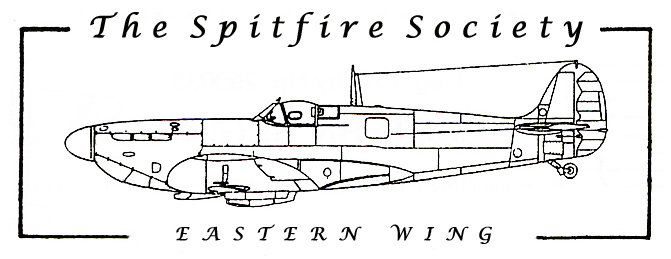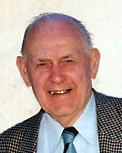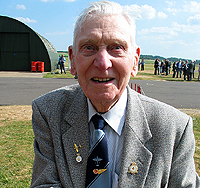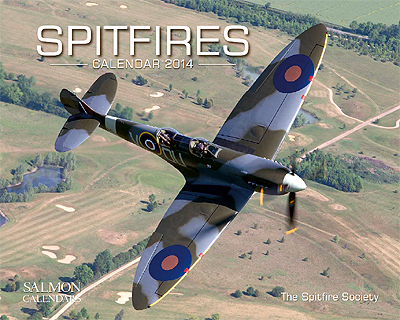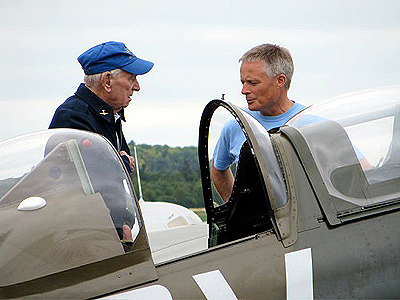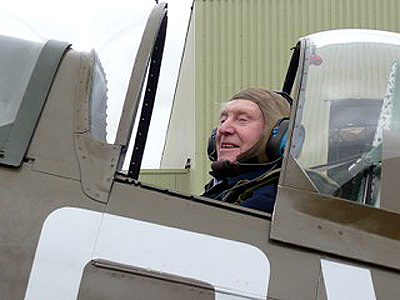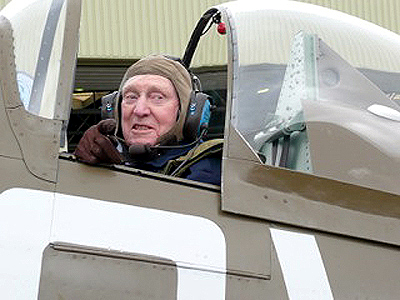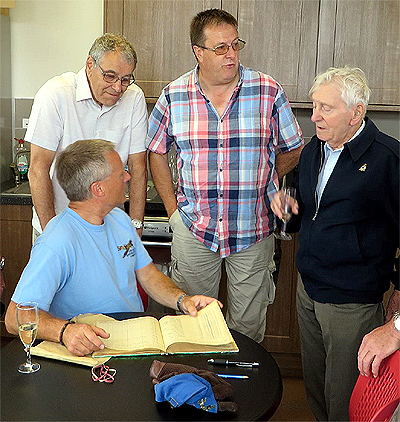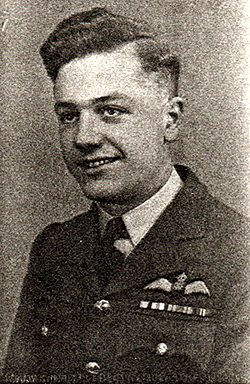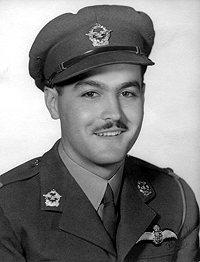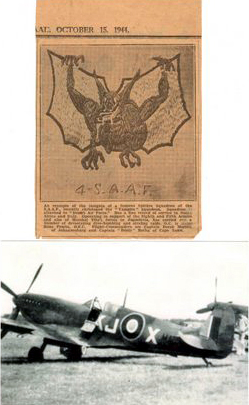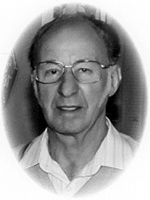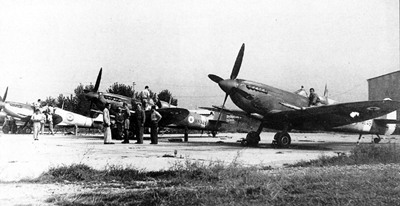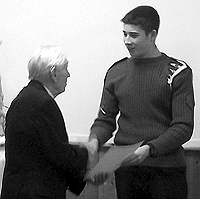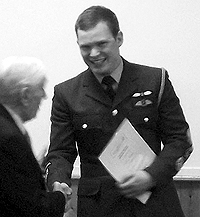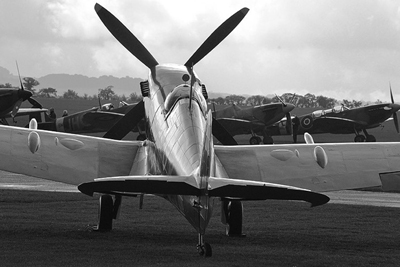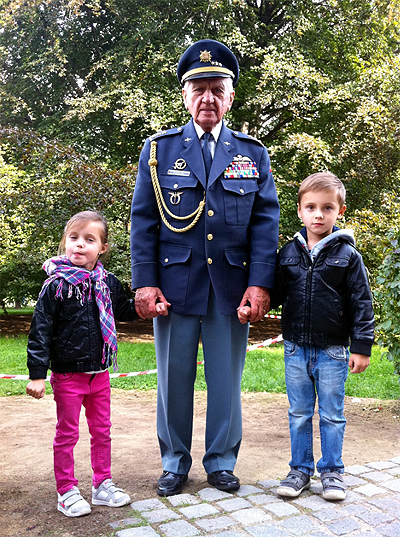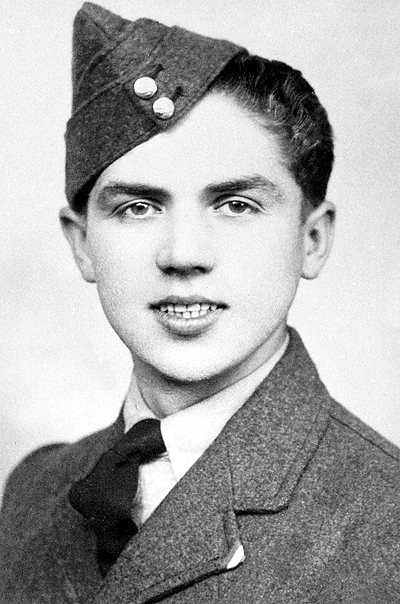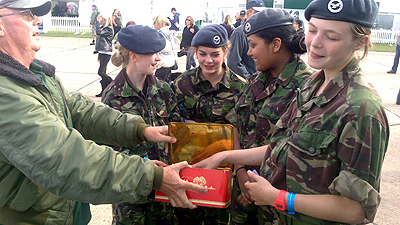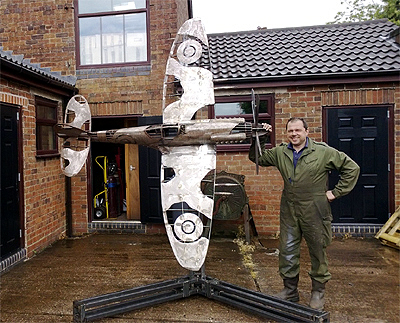 Home Page
Pat Butler
|
(Regional newsletters were discontinued in 2014) Form 700 No. 60 February 2014
INDEX
From the Chair
General Announcements
95th Birthday Flight - Ian Blair
Lt John Henry Martin 4 Sqn SAAF
The Butler / Stillwell Memorial Awards
Commemoration of The Battle of Britain
----------
It is with real conviction that
I pen these few words. The Eastern Wing is entering a very
bright and fruitful future; however, it is not unusual at this
time to pause and reflect a little.
Our seven visits to Duxford were
more successful than expected. I offer my heartfelt thanks to
everyone who works on the stand and to all those who make it
possible; the prevailing spirit and atmosphere makes it all very
rewarding.
Sadly, we recently lost a very
good friend in Norman Pascall. We will miss him very much.
I would like to wish you all a
very healthy, happy, and prosperous New Year.
From wherever you come, or are
going to;
“Keep the Faith”. David
----------------------------------- Welcome to Form 700 Welcome to edition number 60 of the Eastern Wing’s Form 700 Newsletter.
One of our most active members Squadron Leader Ian Blair DFM (RAF Retd)
celebrated his 95th Birthday last year. Ian was one
of the earliest members of the Eastern Region and still drives
up to nearly all of our activities and fundraising events to
help out, willingly lending his knowledge, energy, enthusiasm
and status to raise funds and fly the flag for the Spitfire and
our society. We will be marking the occasion with a number of
items in this issue, including his account of a special
celebratory flight. In other news we are saddened to report the passing of one of our most
dependable and dedicated members Norman Pascall; a tribute to him
is included elsewhere in the magazine. The Eastern Wing AGM went well in April and as in previous years was
preceded by the Butler/Stillwell Awards presented to outstanding
ATC cadets in honour of our region’s founder the late Pat Butler
and long-term committee member Len Stillwell; report inside. On Sunday the 15th of September a service was held at St.
Andrews Church North Weald to commemorate the 73rd
anniversary of the Battle of Britain. The hymns were Our God,
Our Help In Ages Past, The Airman’s Hymn and Jerusalem, and God
Is Our Strength And Refuge, poignantly sung to Eric Coates’
Dambusters score, last year of course being the 70th
anniversary of the raid. As in previous years loyal and steadfast Eastern Wing member Eric Horwood
arranged the wreath which was laid at the cross of sacrifice by
our chairman David Williams. On Remembrance Sunday a wreath was laid at the North Weald Airfield
memorial opposite the airfield museum at North Weald Bassett,
Essex. Readers may be interested to know that a well-presented and moving film of
the 2011 remembrance service may be found on YouTube, entitled
North Weald Airfield Remembrance. This year’s fundraising efforts at the Duxford Air Shows went as well as
reasonably possible though this year we had a number of extra
hurdles to navigate such as problems with stock, the great
British weather and of course the current financial climate,
which meant that extra effort was required to help lever funds
from the public’s pockets and into the Spitfire Society’s
coffers. However our loyal band of volunteers – as well as a few
very welcome new helpers – rose to the challenges magnificently
and on the whole things could have been a lot worse. We were
very pleased to welcome Pat Butler Awardee Cadet Warrant Officer
Christopher Perkins who came along to help out this year; Chris
attended the autumn air show and anyone who was there will tell
you how discouraging to say the least the weather looked that
day. The rain was pouring in stair-rods all morning and it
looked very much as if it would all be a wash-out. However, by
the afternoon it eased off and things started to fly about, and
even though there were regular bursts of wet-stuff the air show
went ahead without a hitch – in fact the sun even came out a few
times! We would like to take this opportunity to thank those people who give up
their time to come along and raise money for The Spitfire
Society; your enthusiasm, dedication and hard work is greatly
valued and appreciated. New Helpers Welcome! New volunteers are always welcome to help out on The Spitfire Society's
Duxford sales stand at air shows; it is a rewarding day out and
helps raise vital funds to help keep the society going, so if
you would like to lend a hand please contact Steve Beale or any
other member of the committee. 2014 Duxford air shows: 24th/25th
May, 12th/13th July & 13th/14th
September. Appeal for stock Do you have any books, magazines, aeroplane related items (old
spade-grips, gun-sights, propellers etc) that are now collecting
dust and could usea new home?
Perhaps you might consider donating them for sale on our sales
stand to help raise funds for The Spitfire Society? Donations
gratefully accepted. Careless Talk May Cost His Life
To mark the occasion of Sqn Ldr Ian Blair's 95th Birthday, the
Eastern Wing has brought out a presentation pack based on the
celebrated wartime poster which featured Ian in full flying kit,
but in mortal peril from those who would discuss aerodromes and
aircraft factories with the enemy. The pack features eight fine
quality A5 cards telling the story of his illustrious wartime
career including the Derna incident, which preceded his being
awarded the Distinguished Flying Medal. Photographs include
Ian's Spitfire MkVII and gun-camera still from the famous 'Skeabrae’
incident, Ian sitting on the wing of a Mk I Blenheim in 1940,
and of course the colourised poster signed by Ian himself.
Compiled by Ian Blair and Eastern Wing Committee member Gerard
Crutchley, each set is individually numbered as part of a
strictly limited edition run of just one hundred packs. The cost
is £10 to Spitfire Society members, £15 to
non-members (£1 p&p); we have already sold a good number of the packs and
they are going fast, so if you would like one you will need to
act now. Please contact Gerry Crutchley to obtain your pack
(maximum of two packs per member).
Calendars for 2014 The Spitfire Society calendars for 2014 are
now on sale and follow the same popular arrangement as in
previous years; twelve beautiful colour photographs, with the
calendar presented underneath. Once again the pictures come to
us courtesy of Darren Harbar and James Wheeler, two very gifted
photographers to whom we extend our thanks. These are always a
popular item due I’m certain to the combination of high quality
and very reasonable price.
The calendars
are priced at £6.10 including postage and may be obtained from
Eastern Wing Committee member Jason Amiss, whose contact details
can be found on the back page of this magazine.
P.W. ----------------------------------- 95th
Birthday Flight - 69 Years On By Ian Blair DFM 19th July 2013
marked my 95th Birthday.
My family arranged a
'surprise' for me, which I was unaware of until a few
days before. I was taken out for lunch on the 19th
and told I would be collected at
10am the following day for
my surprise.
And surprise it was. The
whole family plus grand children, great grandchildren
and their respective
boy/girlfriends met up in the car park at the Duxford Imperial
War Museum at 11am. A
convoy of 6 cars then ferried the gathering to the main gate
where we were met by John Smith of the Aircraft Restoration
Company and taken to the hangar.
The IWM was very quiet,
personnel and flying non-existent—unusual to see Duxford like
that considering there were thousands of people there the
previous weekend.
On arrival at ARC our party
of 30 were guided to the hangar to find a vast open space; it
was only then when well inside I spied the
Spitfire TR 9 PV202 parked
on the apron outside.
I always made it known that all I wanted to do was to 'fire-up'
the Merlin and taxi
the aircraft a few yards; at the back of my mind I thought that
now was the time. In the hangar John Romain was standing near the Blenheim and John Smith
had all my family on a
conducted tour of the Blenheim and the Health and
Safety requirements in the
hangar. All this took about an hour during which
time I was chatting with
John Romain. He said to me we'd better get on and we
walked over to the TR 9.
Some steps had
been placed adjacent to the aeroplane and I managed to get up
saying to JR "I don't suppose I can go in the front seat?" He
didn't say no but helped me into the back seat and began
strapping me in! I had not
sat in a Spitfire for 69 years. It didn't have a rear seat then!
I could see that it was very small.
The parachute harness was
duly clipped on. I secured the clips, which was
the first action of the day. The seat harness was next, the attachments
and fastening were much different i.e. hooks and small
connectors. JR pointed to a
small rotary lever on the right hand side and said "when we
get to the runway I'll ask you to close the hood".
It was then I realised that
this was not just a taxi-ing exercise; I was in fact
about to get airborne! I then had a helmet placed on my head,
done up and a small 'black box" with a
boom microphone fitted. I was
now set up for the trip. I had mentally rehearsed over
the past few days where all the knobs and levers were but I
couldn't remember where the radiator shutter lever was.
JR told me during our
discussion in the hangar that it was all automatic now
so I didn't really have to worry anymore.
I had a good look round the
cockpit; all the usual instruments were in the
usual place except the
flap-control valve which is now near the throttle. I
attempted to set the gyro
heading, only to find there was no compass in the rear
cockpit! (I got a reasonable heading when we lined up for takeoff on runway 060).
When I was initially strapped in, it
was necessary to raise the seat. The operating lever was on the
right, press to release and pull the lever up or
down. I did this but the
seat was spring-loaded and lifted me vertically. I found
there was insufficient clearance between that lever and the
cockpit hood-winding lever - as a result my hand was jammed
between the two during movement, which caused alarm and the
shout for plasters and a glove!! The start up
procedure was quite normal, the engine sounded rough due to
vibration and I was told it was caused by the additional cockpit
seat being 2 feet further
back. In addition, being a 2 seater, there were more exhaust
fumes than I expected.
On taxi-ing out
I found I couldn't move the seat up or down as it seemed to have
locked stopping me from operating the hood closing mechanism. I
mentioned this to JR but the vibration from taxi-ing over rough
ground, caused it to clear itself. When we got to the take-off
point, I closed the hood as instructed and the pilot ran up the
engine, checked the magnetos for mag drop. Everything was OK!
Engine temperature and pressure fine. Flaps up check and we were
off on the take-off. The run itself
appeared 'hard', not as I experienced 60 plus years before.
However I put this down to the fact that aircraft then were well
"run in". Perhaps the oleo legs had different pressure compared
to the current TR 9, which would result in this 'hard bounce'.
We did our circuit and the undercarriage check which was the
‘main object of the exercise’. The finale was a
low pass at 100 feet before the final circuit, much to the
delight of the family below, all waving furiously. It was a
beautiful memory when the TR 9 was throttled back for the final
approach, the crackling and popping of the engine was a very
emotional reminder. On our return to
the dispersal and switching off, we both retired to the ‘flight
office’ where the champagne flowed freely.
Finally John
Remain had a look at my original log book and I asked him to
sign the flight and last entry which he was happy to do. All in all a day
to remember. (pictures
courtesy of Gill Hobbs) ----------------------------------- Part V Geoff Bates If you have not read Part I - IV, you can find
them here:
Our next leg was
to Oslo. Although the war was over, Sweden was still observing a
form of neutrality. The weather was reasonable until we reached
the fjord leading up to Oslo when suddenly we flew into a thick
wall of cloud, reaching almost down to the water at times. There
were islands in the fjord with very tall trees. We were led by
an Anson with a radio, but we had none. As soon as we hit the
cloud we lost sight of each other. I flew straight ahead with
full throttle, climbing as steeply as I dare. Eventually, I
broke cloud which stretched as far the eye could see; there was
no sign of the other aircraft. I hadn’t any
idea what the weather was like at Oslo; if it was covered I
wouldn’t be able to get through the cloud in safety and, by that
time, I wouldn’t have had enough fuel to get to Goteborg in
Sweden, which was the nearest place with an aerodrome. Even when
I broke cloud I hadn’t enough fuel to get to Copenhagen. I
decided I had no alternative than to make for Goteborg and hoped
I would not be interned. I duly landed at Goteborg. What a
reception! At the dispersal
area, two soldiers complete with rifles came up to me. I was
taken to Air Traffic Control, where a very hostile Major greeted
me. To say that he was aggressive would be putting it mildly!
In the midst of being interrogated by the Major, the telephone
rang. He told me that another of my party had landed on an
emergency strip some 80 miles north of Goteborg. The call had
been from the local policeman who was told by the Major to tell
the pilot to fly to Goteborg to join me. I got permission
to ring the British Consul who agreed to meet the cost of lunch
for us and also to contact Oslo and ask them to let the Major
know as soon as the weather would allow us to get into Oslo. At 5pm we went
to get some tea and were greeted by the Major who was quite
friendly, no doubt because he would be getting rid of us. Oslo
had rung to say the cloud had lifted and we could proceed there.
The Major even walked us to the aircraft, shook hands and waved
us off! We safely made
Oslo and had our legs pulled when we met up with the other
pilots, although they did agree that it had been a hair-raising
experience for them. We had the last laugh as on return to base
the C.O. congratulated us on not having put His Majesty’s
aircraft at risk. Afraid the other four got a ticking off.
Fire! By the time we
had returned from our trip to Oslo, those who had been in the
RAF virtually from the beginning of the war were being demobbed.
This meant that initially the rest of us were quite busy taking
mainly Spitfires to Cairo and India. We were now flying the
Spitfire XVIII’s which had Griffon engines and a maximum speed
of 448mph compared with the Spitfire IX’s 408mph. We were taking
the Spit’ XVIII’s to Fayid, near Cairo and were escorted by a
Beaufighter flown by a rather cocky pilot who knew it all. At
Elmas in Sardinia I had trouble starting my Spit’. The rest of
the convoy were taxiing out for take-off so as not to overheat
their engines. The Beaufighter pilot suddenly jumped up on my
wing sticking his head in the cockpit saying that the engine
needed more priming, and before I could stop him he grabbed the
throttle and pushed it forwards and backwards to prime the
engine. Despite his being senior in rank to me, I got really
cross with him and told him that he could have over-primed the
engine. I pressed the starter button again; a loud explosion,
the propeller started to turn and suddenly flames shot out of
the engine! I was already strapped in. I had them undone in
record time, was out of the cockpit in a flash and did twenty
yards in a Mae West with a parachute and dinghy strapped on in
record time! The ground crew
got the fire out quickly, but the aircraft sustained category
‘C’ damage and was ‘struck off charge’, never to fly again. It
was quite obvious the Beaufighter pilot had over-primed the
engine and hence the fire. What I said to him didn’t bear
repeating! He didn’t argue with me or pull rank. I said in the
report to the CO what had happened and passed it on. I was more
than surprised to hear no more. Had he got friends in high
places! Now how do I get
back to the U.K? Normally only fighters going eastwards called
at Elmas for refuelling. My luck was in at someone else’s
expense. The Beaufighter’s Navigator’s father had suddenly died
and by diverting a Dakota U.K. bound he was able to get home for
the funeral. Here comes the punch line. The Beaufighter’s pilot
asked me if I would like to take over as navigator for the rest
of the journey! The fire was never mentioned.
The Customs Officers are waiting After one flight
to Fayid, I found an Argus which had to be taken to Almaza on
the outskirts of Cairo. There, I managed to get a flight home in
a York. We had several Army personnel aboard. We were heading
for Lyneham but couldn’t land there because half way across the
channel we hit a solid wall of cloud right down to the sea. It
was a Sunday, so most RAF stations were on stand-down. We were
diverted to Prestwick in Scotland but couldn’t get in there.
Re-routed to Blackbushe, we had to circle until a flare-path had
been set up. By the time we landed, the aircraft had fifteen
minutes of fuel left. The army personnel thought it was
exciting. We were biting our fingernails! It was late at
night, and as there were no customs facilities we were impounded
in the canteen until the Customs Officer arrived from Croydon. I
had bought some table linen as a wedding present for a former
House Captain who I had met in Rome and was severely injured a
few days later. Although I declared the table-linen and paid
duty on it I had my night-stop bag thoroughly searched, whilst
nobody else’s was troubled! I must have a
guilty looking face as time after time my luggage was searched,
whilst the others didn’t trouble the Customs Officer. My
colleagues used to say that if Bates is aboard we can get away
with smuggling anything into the country and, believe you me, no
end of it went on. I think I should have taken ten percent of
their takings. One chap used to wrap dress-material under his
uniform and was never caught!
To
be continued… -----------------------------------
4 Squadron - Part of 7 Wing SAAF
I did my ground training and studies at Lyttleton Air School,
where I also did a course on Gliders.
I did my initial flying on Tiger Months DH 82A at Randfontein
from April 19th 1943 - 25th June 1943 (78 Hours).
I then transferred to 22 Air School in Vereeninging on the 1st
July 1943, flying Harvards (187 Hours). I got my "wings" on 13th
November 1943 (Total flying hours at this stage 240)
Began to train for operations at 11 O.T.U. Swartkops, flying
Kittyhawks. Completed this course on the 29th January 1944 (53
Hours).
I then flew to Cairo on the 2nd March 1944 and was posted to 73
O.T.U. at Abu Sueir to convert onto Spitfires Mark I and Mark V
- (completed 20 hours).
I was then posted to Italy for further training on Spitfire V's
(15 Hours) on the 27th May 1944. I was then finally posted to
Sinello - where I joined 4 Squadron part of 7 Wing (1, 2, 4 and
7 Squadron).
Tested first flight in Spitfire IX on the 29th May 1944.
Completed my operational tour on 19th March 1945, having spent
10 months on operations with the Squadron as we progressed North
through Italy, operating from 9 different airfields, carrying
500 lb bombs and doing close support work, armed with 2 x 20mm
cannons and 4 machine guns, with the advancing army on the
ground. Completed operational tour after 150 Sorties and 200
operational hours, and on the 19th March 1945 when I returned to
The Union of South Africa.
In June 1945, I converted on to "Twins" flying Oxfords at Nigel
at 24 Air School where I completed a 30 hour course on 29th June
1945. I transferred to 5 Wing SAAF on July 5th 1945 and went to
Cairo and back as the second pilot on a DC3. I returned to
Zwartkops 11th July 1945.
I found this very boring and I opted out and I went to 43 Air
School in Grahamstown where I flew Ansons and Harvard's,
training Air Gunners. I finished in Grahamstown on the 15th
September 1945 and I was discharged and back to "Civvies" in
Johannesburg in December 1945.
Total Flying Hours 651
SOME INTERESTING POINTS: During the 10 months that I was in the
Squadron, 25 Spitfires were shot down in my squadron resulting
from "flak". Of these, there were 14 who bailed, 5 POW and 9
were killed.
Last Flight 15th September 1945 in World War 2 in a Harvard.
PLANE
HOURS NIGHT HOURS
TIGER MOTH DH82A 77.55
6
HARVARD 2A
187 14
KITTYHAWK MARK 1 53.13
SPITFIRE Mks 1, V, IX 242
OXFORD TWIN
30.2 6
ANSON TWIN
13.5
DAKOTA DC3 TWIN 46
9
Further information on John Henry Martin can be found here:
http://saafww2pilots.yolasite.com/john-martin.php
(Thank you Michelle for sending us your father's service
details)
----------------------------------- Norman Pascall In October of
last year we lost a good friend and colleague when wing member
Norman Pascall passed away. Norman had for
many years been one of the key figures in our region; along with
his wife Irene (or Renee as we knew her) who died in 2009,
Norman supported all of our events and activities, generously
giving his time and effort to work tirelessly year in and year
out raising vital funds on our sales stand at air shows. The raffle sales
team of Norman Pascall and Eric Horwood was a formidable one,
their direct yet friendly approach charming the members of the
public every time; it is impossible to estimate how much money
they raised over the years but it certainly must run to many
thousands of pounds. Norman was a man
of high standards, principles and values, a man who was not
afraid to talk straight and to look you in the eye. He was also
a man of great wisdom and his pragmatic approach to problems
stood us in good stead on many occasions. This coupled with his
gentle sense of humour made Norman a delight to work with, and
we shall miss him very much. Norman had what
the Americans would call ‘The Right Stuff’; he represented the
best of The Spitfire Society and the society is in his debt. Our
kindest thoughts go out to Norman’s family and friends. P.W.
-----------------------------------
By Steve Williams
Much information in this piece is taken from the form AM78
(airframe record card) for this aircraft. These cards are not
particularly accurate especially with regard to dates. This
should always be borne in mind.
Mk LF IX MH526 is a very well known Spitfire. It features in at
least two works by well known aviation artists and decals of its
markings are available for modellers. This fame is, of
course, due to its association with the controversial French ace
Pierre Clostermann but our members may not know that it was
previously ‘owned’ by Eastern Wing stalwart Squadron Leader
(then Pilot Officer) Ian Blair whilst they were both serving
with 602 (City of Glasgow) Squadron.
MH526 was built at Castle Bromwich and it would have been good
at this point to say it was tested by another great friend and
supporter of ours, Alex Henshaw. Alas, such was not the case,
but he did fly its numerical successor off the production line.
The first three lines on the AM78 read as follows (with location
inserted):
39 M.U. (Maintenance Unit)
Colerne,Wilts 21?.08.43
405 A.R.F. (Aircraft Reception Flight), Heston, Middx 22.09.43
602 Sqn., Newchurch, Kent
06.10.43
Circumstantial evidence points to a delivery to 602 on the 29th
September 1943. However, what is known is that Ian flew it for
the first time on the 2nd October (a cannon test) and that it
was given the code letters "LO-D". 602 was part of 125 Airfield,
2nd TAF (Tactical Air Force). 125 Airfield consisted of 132 and
602 Sqns re-equipping with Spitfire Mk LF IX from Mk LF Vb, and
184 Sqn with the rocket armed Hurricane IV. It occupied tented
accommodation at Newchurch, moving to winter quarters at Detling,
also in Kent, on the 12th October.
602 flew its first sweep with the Mk IX on the 8th October with
Ian at the controls of MH526. He continued to fly it on almost
every operation in which he participated for the next three
months. In January 1944 the opportunity was taken to rest the
2nd TAF Spitfire units and ADGB (Air Defence Great Britain,
formerly Fighter Command) squadrons were brought in to cover. In
125 Airfield, 132 and 602 were replaced by 118 and 453
respectively, and both left by rail for a spell in Scotland.
453 (Royal Australian Air Force) Squadron arrived at Detling by
Harrow transport aircraft and rail on the 19th January and took
over the Spitfires left by 602. Information from Australia
suggests that 453 used the aircraft in 602 Squadron markings
during this period. Although not mentioned in any documents that
I have found, it would appear that modifications to permit a
bomb carrier to be fitted were made at about this time.
602 returned to Detling from its Scottish sojourn on the 12th
March 1944 and at the same time some organisational changes were
being made. It was decided Airfields should only operate one
type of aircraft and so 184, with its Hurricanes, left and 453
was transferred to 2nd TAF joining 132 and 602 as an all
Spitfire wing. 602’s original outfit of Mk IX’s was returned by
453 who then received replacements flown over from Hornchurch by
504 Squadron. Having survived the gentle ministrations of the
men from down under, MH526 resumed service with 602, but without
its original regular pilot for another change had seen Ian Blair
transferred from A Flight to B Flight and he never flew it
again.
In readiness for D-Day, 125 Airfield moved to Ford in Sussex on
the 18th April and dive bombing of V-1 launch sites was added to
the daily routine of bomber escorts. 125 Airfield became the
more appropriate 125 Wing on the 12th May, a title already in
colloquial use. The name Clostermann now begins to feature
regularly as its pilot shown in the Squadron records.
The
Form 541 (Record of Operations) for 602 show MH526 making two
sorties on D-Day, both uneventful patrols, but at this point
matters become rather confusing.
MH526's successor as "LO-D", MJ586, first features in the Form
541 on the 16th June and thereafter the two seem to alternate in
the record until the 28th June. It is probably significant that
they never appear together and it was as though the Orderly Room
had no idea which aircraft code "LO-D" actually was. Whatever
the truth, MH526's time with 602 was finally up. The next items
on the AM78 read:
83 G.S.U. (Group Support Unit) Bognor, later Thorney Island,
both in Sussex
06.07.44
Scottish Aviation R.i.W (Repair in Works) Prestwick
03.10.44
AW/CN
(AwaitingCollection)
13.12.44
9M.U. Cosford,Shropshire
09.01.45
G.S.U.s were reception and holding units for aircraft and
aircrew intended for the Groups they served. What, if any, use
MH526 was put to at this unit is hard to say. It underwent a
general overhaul by a civilian company and was returned to the
R.A.F. in the new year. The next phase in MH526's career was
about to begin as shown in the AM78:
RAF Pershore,
Worcs. 10.4.45
Dispatched to M.A.A.F. (Mediterranean Allied Air Forces) 25.4.45
Arrived M.A.A.F.
30.4.45
At Pershore, presumably with No.1 Ferry Unit based there, it was
prepared for a delivery flight across France to Italy and on
completion of this trip receipt was signalled on the 30th April
1945. Unfortunately for us, R.A.F. Commands overseas did not
keep records of aircraft on their charge and with the end of the
war, squadron diaries seldom mention serial numbers. Anecdotally
service with 253 Squadron has been mentioned but I can find no
real evidence for this. The AM78 concludes with:
Italian Air
Force
26.6.47
The book "Spitfire Italiani" by Gregory Alegi and Marco Gueli
states that MH526 was given the Italian identity of MM4037 and
was allocated to 5 Stormo on the 15th December 1947. This unit
began re-equipping with Mustangs in 1949 and she passed out of
service in January 1950. There is no information as to its fate
so one would guess that, sadly, it was scrapped.
If you can make corrections or additions to any of the above I
would be delighted to hear from you.
(MM4037
Photo copyright A.M.I.)
-----------------------------------
The Pat Butler Award is presented
annually to two ATC cadets, who are chosen by the Officers
Commanding, London & South Eastern Region, Central and East
Region Air Training Corps, as being two of the most hardworking
and outstanding cadets from these regions. Pat Butler, who died
in 1993, flew Spitfires from 1942 onwards, serving first with
1435 Squadron in Malta followed by 130, 256 and 153 Squadrons in
North Africa, Sicily and Italy. Pat was one of the original
members of The Spitfire Society and the founder of Eastern
Region and these awards which consist of a certificate, a
bursary, and membership of The Spitfire Society are made in his
memory. A similar award is
made in honour of the late Len Stillwell and is presented to the
most promising ATC cadet. Len was also a wartime Spitfire pilot
flying in Italy with the famed 92 Squadron and despite being
badly wounded in action, Len continued to fly as soon as he was
able. Len served on the committee for the Eastern Region of The
Spitfire Society for many years and alongside his wife Dot was
also a hardworking stalwart of the regional sales stand, helping
generate thousands of pounds for The Spitfire Society over many
years despite a number of personal hardships including his
wartime wound which continually plagued him. When Len died in
2008 he bequeathed a large sum of money to The Spitfire Society
which we have been using to help benefit the society and others
including Flying Scholarships for Disabled People (see Form 700
No. 59, winter 2012). Pat and Len – and
indeed Dot, a wartime WAAF who worked on bombers such as the
Wellington, Halifax and Lancaster in Yorkshire and Lincolnshire
– represented all that is good about the Spitfire and The
Spitfire Society and we are proud to make these awards in their
name to the three young people below, of whom we include a
selection of just some of their achievements so far.
Pat Butler Awards
Flying Cadet Tom Lawlor began his
service with the Air Training Corps in 2007 and has since
completed a gliding scholarship, begun as a Flight Staff Cadet
at RAF Odiham, completed Wing NCO courses, a rock-climbing
course, annual camp both here in the UK and at RAF Akrotiri in
Cyprus. Tom has always had a keen interest in the RAF and his
ambition is to continue with them and fulfil his wish of an
aircrew career. With the enthusiasm, application and dedication
that Tom has shown thus-far with this impressive account of his
achievements we feel sure that his hopes will become reality in
the near future.
Cadet Warrant Officer Christopher
James Perkins enrolled in the ATC in May of 2009. Courses
completed have included the Qualified Aerospace Instructor
Course, Air Cadet Gliding Scholarship (motor glider), the Ralph
Reid Buckle Memorial Award Gliding Bursary, the Charles Newton
Memorial Award (light aircraft) and Radio Communicators course.
Chris was one of Northamptonshire’s Lord Lieutenants’ Cadets
from October 2012-2013 and has twice represented the Lord
Lieutenant at important and prestigious events. Christopher has
been a staff member of 616 Volunteer Gliding Squadron for three
years, gaining his Grade 1 Glider Pilot wings in March 2012 and
works closely with 1101 (Kettering) Squadron’s training flight
whom he was in charge of for eighteen months before his
promotion to Cadet Warrant Officer. During his time with the
squadron he was the banner bearer for several years and now
helps train the current banner drill team. Chris is currently
seeking a scholarship to pursue his desire of becoming a pilot
either within the RAF or commercially, and his impressive
curriculum vitae so far must surely stand him in excellent
stead.
Len Stillwell Award
Cadet Warrant Officer Sandra Scott
joined the Air Training Corps in August 2006 and served with
2470 (Sudbury) Squadron until she aged out. During her time with
the cadets she took full advantage of everything that was
offered to her. In 2010 she completed a gliding scholarship at
611VGS gaining her silver wings and then going on to attend the
school for a further year as a flight staff cadet.
In 2012 following completion for a
flying scholarship Sandra flew solo and became the first cadet
from 2470 to gain this award. Sandra has been enthusiastically
involved in almost all sporting activities, twice representing
the region, and gaining twenty-six wing sporting blues as well
as gaining her regional marksman award achieving best marksman
within her squadron on three occasions and best shot within the
Norfolk and Suffolk wing two years in a row.
At the start of 2012 CWO Scott was
selected as the Lord Lieutenant’s Cadet for the county of
Suffolk. As part of her duties she has attended several special
events escorting the Lord Lieutenant of Suffolk and several
members of royalty. This lead to being nominated for the Dacre
Brooch, an award given annually to the top female cadet in the
Air Training Corps.
Now in her second year at University,
Sandra is very much focussed on pursuing a career in flying.
Flight Lieutenant R. Appleby, Officer
Commanding 2470 (Sudbury) Squadron spoke very highly of CWO
Scott in notes supporting nomination of the Len Stillwell award;
a small extract reads; ‘Her achievements are both remarkable and
impressive and have served to show fellow cadets and the local
population just what can be achieved by being a member of the
Air Training Corps. Furthermore, she has made a valuable and
commendable contribution to the administration and overall
running of her Squadron. It is fair to say that without Scott’s
involvement, hard work and enthusiasm towards all aspects of
squadron life the squadron would not be in the position of
strength it enjoys today’.
Truly inspiring words and I am sure
that the spirit of those words and the dedication of Sandra,
Christopher and Tom may be found within countless cadets at ATC
units across the nation, and long may it continue to be so.
On behalf of The Spitfire Society we
would like to send our very best wishes to these three
remarkable young people and our hope that they continue going
from strength to strength into the future.
PW ---------------------------------- Andrew Pierce has sent us
this lovely photo taken at Duxford during the 2013 Blenheim day:
Albert Kronek from the Air Cafe in Brno has sent us this photo
of his children with Flight Sergeant Emil Boček:
Emil is the last Czech Spitfire pilot still living in the Czech
Republic:
ATC cadets at Duxford picking our raffle winner - thank you
Trevor Burton:
Steve Beale spotted this Spitfire at the Barcelona Good Food
Market:
Pat Pearce sent us this photo of his son Stefan's project - a
steel Spitfire sculpture with a 9 foot wingspan:
Further details of the project can be found here:
http://www.kestrel-forge.co.uk/current-projects/spitfire-late-for-the-fight ----------------------------------
This address originally appeared in an earlier Form 700. I would like all our visitors to read it and I am
in the process of finding a permanent 'home' for it on our site.
Commemoration of the Battle of Britain
2008 address by the Rev'd Frances Drake
It is a great privilege to be here today - and I thank you for
the Invitation - to share in this Service of Commemoration and
Remembrance - of the Battle of Britain. As the words in the 'Act
of Remembrance' remind us that:
'We are remembering before God ....... those who fought and died
in Service - in the Battle of Britain -
treasuring memories - and pledging to keep alive the memory of
all those who died in the Royal Air Force - and in the Air
Forces of the Commonwealth.'
My own knowledge of the war is very limited - although not
entirely non-existent. I am a war baby - but along with many
others of my generation over the years - I have listened with
interest
and admiration - to accounts of various war time experiences -
including the Battle of Britain.
Living relatively locally to here - at Navestock - with a Father
who was in charge of a 'Home Guard Unit' at Stapleford Abbots -
and living in a family - where my sister Joan - my parents first
child, was killed in 1940 - during the Battle of Britain - and as
the direct result of a jettisoned German Bomb - I have
experienced and heard a great deal about war time events - and
what people lived through - both in the Forces - and in civilian
life.
I almost 'cut my teeth' on what have become immortal words from
Winston Churchill. 'Never in the field of human conflict - was
so much owed - by so many - to so few'
My parents would often speak of Churchill's speech to the House
of Commons in the June of 1940: 'You ask', he said - 'What is
our aim? I can answer with one word - Victory' - and he went
on to say. 'Victory at all costs. Victory in spite of all the
terror. Victory, however long and hard the road may be. We shall
not flag nor fail. We shall defend our island to the end - with
confidence - strength and courage'.
So today - we remember those who led and inspired - as well as
those who fought. And we remember those civilians - who kept on
going - in spite of the pain - the terror - the deprivations -
and death itself.
Each of those who fought - and who are remembered at this time -
has won a glorious grave - not that grave of earth wherein they
lie - but the living grave of everlasting remembrance - wherein
their glory is enshrined. A Remembrance that will live on the
lips - that will blossom in the deeds - of their countrymen -
the world over.
For the whole world is the tomb of heroes. Monuments may rise
and tablets be set up to them in their own land - but on far-off
shores there is an abiding memorial - that no pen or chisel has
traced; because it is graven - not on stone or brass - but on
the living heart of humanity. Let us take these men as our
example.
Let us like them - remember that prosperity can only be for the
free; that in the words of Pericles of the 5th Century - 'freedom
is the sure possession of those alone - who have courage to
defend it'.
We are to take these men for our example. There is always a
danger however - that things - events - memorials - even our own
Christian faith - can become purely nostalgic - a memory of past
things - sometimes becoming distorted and false in our memory
-something that older people do - and young people tolerate -
but the true meaning and value is lost in time.
History can become an empty husk - fragile - and eventually
meaningless. But our celebration today is far from an empty husk - and if we
seek to understand it properly - it transcends a particular time
in history - or even the RAF - or our nationality - because it
is about the men and women who made the history. It is about their
values - their courage - their sacrifice - and their characters.
This is what is valuable. This is what should be our treasure -
not merely as nostalgia - but as an example of
something real and substantial.
For they have lived the values - that should still be relevant today - and everyday after
today.
The values we celebrate in a Service such as this - do not
change.
They are values for every generation and nationality - that
those who wish to live their lives to the full -
will recognize and acknowledge - and take for an example.
This is not nostalgia - but is rather - real and abiding - and
something worthwhile to pass on from one
generation to the next.
The facts of the Battle of Britain are simple.
In 1940 - out numbered, and fighting for their lives - a few
stood up to the many - and said - 'You will not pass. You will
not overcome. You will not break our spirit'.
What we celebrate - what we admire - is the courage and
character of those young men - that gave them the strength - to put
themselves between the enemy and their homes and families - and
achieve the apparently impossible.
And what are these values?
They are sacrifice and service. Values that are also central to
the Christian faith; for Jesus came into the
Some years ago - I was called out to attend to an elderly man who
was dying. It turned out he had fought in the Battle of Britain.
He had been ill for some time, and over the course of three
years - both his legs had been amputated - not in one operation
- but during a number of these.
As I knelt beside him - ready to give him the last rites - just
as he wanted - he could see that I was upset. He took my hand
and said - 'Don't worry Vicar - I've been going to heaven in instalments'.
Sacrifice and service runs through a person's life - just like a thread
through cloth. For that wonderful elderly man - it was there as
he fought in the Battle of Britain. Sacrifice and Service was
there - as he and his wife worked to make a home for their
children. It was there when he nursed his wife through a long
and painful illness. It was there when he arranged her funeral.
And - it was there - as he himself died whilst offering comfort
to a young priest.
So these are the values that we celebrate today.
Courage; Service before self; Integrity and Bravery.
It is all these things - and so many more - but the most
important is Self Sacrifice.
Sadly - they do not appear to be valued very much by the world.
But to me they are everything.
They are the difference between a life well lived - even if it
was cut short - and a selfish life.
They are the gifts of God - what I would call grace - or the
gifts of the Spirit.
They are the values that help us walk beyond our natural desire
for self-preservation - to meet instead - the
needs of the common good - of others.
What we can all agree on is - that they are at the pinnacle of
what it means to be a human being - for they
are the values that we see lived out perfectly in the life of
Our Lord Jesus Christ.
And as we think about them - we see in their reflection - that
the values so dearly loved by this world - are only shadows -
they are like sand that passes through the fingers and is gone
- but that the values we celebrate today - are solid and hard
won. They are often scorned by those who are weak and self
serving - but equally eagerly embraced by those who see beyond
themselves - those who have the courage to sacrifice their lives
for others - who they do not even know. Those men and women are
those - who recognize what is truly good - and who have the
courage to defend it against all odds.
So let us continue to tell the story of the Battle of Britain to
our children and grandchildren. Let us tell them - how the
Luftwaffe had to destroy the Royal Air Force - before it could
invade. Tell them - how at the beginning of the battle - 2,790
German aircraft were sent against 650 aircraft of the RAF - who
struggled day after day to survive. And then - when your
children ask you how they managed and won - tell them that the
adversity had exposed their true character - and it was solid -
and gave them the courage to lay down their lives - not because
they wanted to - but because they recognized that there are some
things - which are more important even than life itself.
'Never in the field of human conflict - was so much owed - by
so many - to so few'
Amen
--------------------------------------- Form 700
is produced by Peter Wesson and Gerard Crutchley. The previous edition of Form 700 (Winter
2012) can be found here: |
||

